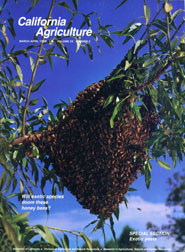


University of California
California Agriculture



|
|||
|
|||

Will exotic species doom these honey bees?
Cover:
European honey bees (swarm shown), whether managed or feral, are seriously threatened by exotic pests, including varroa mites and Africanized honey bees. See pages 7 and 9... Photo by Ken Lorenzen
March-April 1998
Volume 52, Number 2 |
|||
|
University of California, 1301 S. 46th St., Bldg. 478 Richmond, CA
|